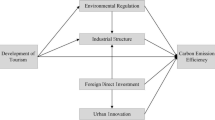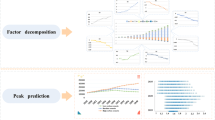Abstract
By revealing the temporal and spatial differentiation of China’s regional tourism carbon emissions and its decoupling relationship with tourism economic growth and identifying the key factors affecting tourism carbon emissions, this paper is expected to provide a reference for the formulation and implementation of China’s regional tourism industry emission reduction policies and measures. Using the tourism’s carbon emission data of 30 provinces (cities) in China from 2007 to 2019, we have established a logarithmic mean Divisia index (LMDI) model to identify the main driving factors of carbon emissions related to tourism and a Tapio decoupling model to analyze the decoupling relationship between tourism’s carbon emissions and tourism-driven economic growth. Our analysis suggests that China’s regional tourism’s carbon emissions are growing significantly with marked differences across its regions. Although there are observed fluctuations in the decoupling relationship between regional tourism’s carbon emissions and tourism-driven economic growth in China, the data exhibit a primary characteristic of weak decoupling. Nonetheless, the degree of decoupling is rising to various extents across regions. Three of the five driving factors investigated are also found to affect emissions. Both tourism scale and tourism consumption lead to the growth of tourism’s carbon emissions, while energy intensity has a significant effect on reducing emissions. These effects differ across regions.



Similar content being viewed by others
Data availability
Original data are available from the corresponding author on reasonable request.
Change history
23 February 2022
A Correction to this paper has been published: https://doi.org/10.1007/s11356-022-19343-3
References
Alajmi RG (2021) Factors that impact greenhouse gas emissions in Saudi Arabia: decomposition analysis using LMDI. Energy Policy 156:112454
Ang BW, Lee SY (1994) Decomposition of industrial energy consumption: some methodological and application issues. Energy Econ 16:83–92
Balsalobre-Lorente D, Driha OM, Shahbaz M, Sinha A (2020) The effects of tourism and globalization over environmental degradation in developed countries. Environ Sci Pollut Res 27:7130–7144
Carlsson-Kanyama A, Lindén AL (1999) Travel patterns and environmental effects now and in the future. Ecol Econ 30:405–417
Castellani V, Sala S (2010) Sustainable performance index for tourism policy development. Tour Manag 31:871–880
Cheng H, Xu Q, Guo YQ (2020) Spatial heterogeneity and driving factors of tourism carbon emission decoupling in China. East China Econ Manag 34:86–93
Gössling S, Peeters P, Ceron JP, Dubois G, Patterson T, Richardson RB (2004) The eco-efficiency of tourism. Ecol Econ 54:417–434
Gössling S, Peeters P, Ceron JP, Dubois G, Patterson T, Richardson RB (2005) The eco-efficiency of tourism. Ecol Econ 54:417–434
He D, Chen K, Zhang TT, Yin MF, Shi XL, Xu Z (2021) Regional CO2 budget and abatement countermeasures for forest scenic spots: a case study of the Shenyang national forest park. Sustainability 13:861–861
Hu LN, Hu HY (2019) Research on the relationship between tourism carbon emissions and economic growth in Tibet based on decoupling theory. J Tibet Univ (Soc Sci Edit) 34:185–192+208
Huang HP, Qiao XZ, Zhang J (2019) Spatial-temporal evolution of tourism carbon emissions in the Yangtze River Economic Belt. Guizhou Soc Sci 02:143–152
Huang GQ, Wang ZL, Shi PF, Zhou Y (2021) Measurement and spatial differentiation of tourism carbon emission decoupling effect in the Yellow River Basin. China Soft Sci 04:82–93
Katircioglu ST, Feridun M, Kilinc C (2014) Estimating tourism-induced energy consumption and CO2 emissions: the case of Cyprus. Renew Sust Energ Rev 29:634–640
Kuo NW, Chen PH (2009) Quantifying energy use, carbon dioxide emission, and other environmental loads from island tourism based on a life cycle assessment approach. J Clean Prod 17:1324–1330
Lenzen M, Sun YY, Faturay F, Ting YP, Geschke A (2018) The carbon footprint of global tourism. Nat Clim Chang 8:522–528
Li ZH, Feng XG, Wang YL (2021) Measurement and spatial-temporal pattern evolution of carbon emission decoupling effect of China's tourism industry. Stat Decision 37:46–51
Lisaba EBF, Lopez NSA (2021) Spatiotemporal comparison of drivers to CO2 emissions in ASEAN: a decomposition study. Sustainability 13:6183–6183
Liu J, Lin C, Huang L, Zhu JH, Wu LJ, Li YY (2017) Use of household survey data as a tool to assess the carbon footprint of rural tourist accommodation and related services in China: a case study of mount Qingcheng. Sustainability 9:1–17
Liu J, Wen D, Tong Y, Ma Y (2019) Research on ecological efficiency of tourism industry in China based on carbon emission accounting. Acta Ecol Sin 39:1979–1992
Ma J, Qing FM (2021) Decoupling relationship between carbon intensity of inbound tourism and economic quantity of tourism in China. Soc Sci 3:40–45
Ma HQ, Liu JL, Gong ZG (2019) Carbon emission and evolution mechanism of tourism transportation in Shanxi province. Econ Geogr 39:223–231
Meng WQ, Xu LY, Hu HB, Zhou J, Wang ZL (2017) Reprint of: quantifying direct and indirect carbon dioxide emissions of the Chinese tourism industry. J Clean Prod 163:S401–S409
Pan Y, Weng GM, Li CH, Li JP (2021) Coupling coordination and influencing factors among tourism carbon emission, tourism economic and tourism innovation. Int J Environ Res Public Health 18:1601–1607
Qiu XP, Fang YP, Yang XT, Zhu FB (2017) Tourism eco-efficiency measurement, characteristics, and its influence factors in China. Sustainability 9:1634–1634
Robaina-Alves M, Moutinho V, Costa R (2016) Change in energy-related CO2 (carbon dioxide) emissions in Portuguese tourism: a decomposition analysis from 2000 to 2008. J Clean Prod 111:520–528
Schafer A, Victor DG (1999) Global passenger travel: implications for carbon dioxide emissions. Energy 24:657–679
Shi PH, Wu P (2011) Preliminary estimation of energy consumption and CO2 emissions in China's tourism industry. Acta Geograph Sin 66:235–243
Sun YH, Yang GC (2020) Decomposition of influencing factors and decoupling effect of carbon emissions from tourism industry in China. China Environ Sci 40:5531–5539
Tang Z (2015) Calculation of tourism carbon emission and its decoupling analysis with economic growth. Stat Decision 02:117–120
Tang CC, Zhong LS, Ng P (2017) Factors that influence the tourism industry's carbon emissions: a tourism area life cycle model perspective. Energy Policy 109:704–718
Tapio P (2005) Towards a theory of decoupling: degrees of decoupling in the EU and the case of road traffic in Finland between 1970 and 2001. Transp Policy 12:137–151
Tian H, Ding CA (2018) Spatial and temporal differences of regional tourism carbon emissions: a case study of Shandong Province. J Beijing Instit Technol (Soc Sci Edit) 20:45–54
Wang L, Fan J, Wang JY, Zhao YF, Li Z, Guo R (2020) Spatio-temporal characteristics of the relationship between carbon emissions and economic growth in China's transportation industry. Environ Sci Pollut Res 27:32962–32979
Wei YX, Sun GN, Ma LJ (2012) Preliminary estimation of tourism transportation carbon emission and regional differences in China. J Shaanxi Norm Univ (Nat Sci Edit) 40:76–84
Weng GM, Li CH, Pan Y, Li JP (2021) Study on the decoupling effect and influencing factors of carbon emission from the tourism industry in China. Geogr Geo-Inf Sci 37:114–120
Yang YP, Wang K (2021) Threshold effect and regional differences of environmental regulation on tourism carbon emission. Areal Re Dev 40:118–122
Zha JP, Tan T, Qian XB, Zhao QQ, Yang XJ (2018) Carbon emission and its driving factors in China's tourism industry. Syst Eng 36:23–36
Zhang GH, Liu J (2015) Analysis on decoupling relationship between tourism development and carbon emission in coastal region of China. Resource Dev Market 31:1352–1357
Acknowledgements
The authors would like to express sincere gratitude to anonymous reviewers for their valuable comments to improve the quality of the manuscript.
Funding
This research was funded by National Social Science Foundation of China, grant number 19CJY040; Social science key research base project of Jiangxi province of 2021, grant number 21SKJD07.
Author information
Authors and Affiliations
Contributions
All the authors contributed to the study conception and design. Data analysis and writing were carried out by Junhong Deng. The reviewing, editing, and supervision were carried out by Guobao Xiong. Theory and method guidance were carried out by Baogen Ding.
Corresponding author
Ethics declarations
Competing interests
The authors declare no competing interests.
Ethics approval and consent to participate
Not applicable.
Consent for publication
Not applicable.
Additional information
Responsible Editor: Ilhan Ozturk
Publisher’s note
Springer Nature remains neutral with regard to jurisdictional claims in published maps and institutional affiliations.
The original online version of this article was revised: In Figure 3c, the label should be 2015~2019.
Rights and permissions
About this article
Cite this article
Xiong, G., Deng, J. & Ding, B. Characteristics, decoupling effect, and driving factors of regional tourism’s carbon emissions in China. Environ Sci Pollut Res 29, 47082–47093 (2022). https://doi.org/10.1007/s11356-022-19054-9
Received:
Accepted:
Published:
Issue Date:
DOI: https://doi.org/10.1007/s11356-022-19054-9




